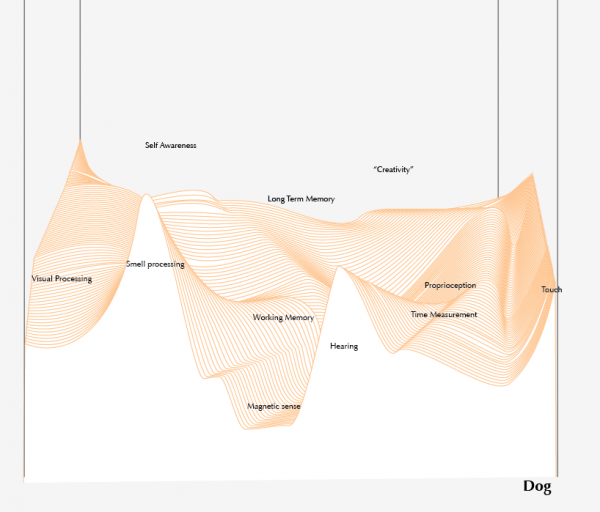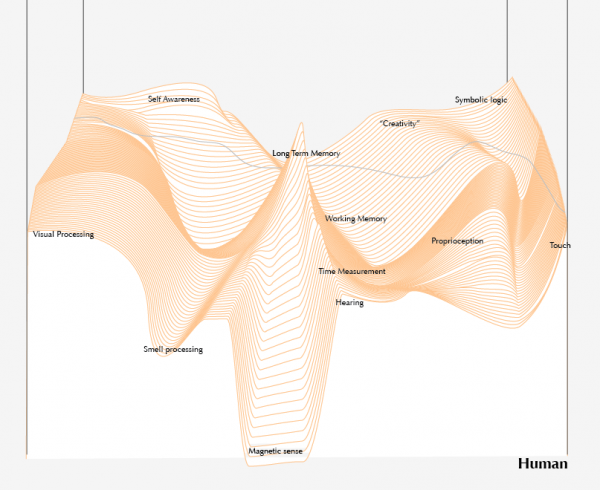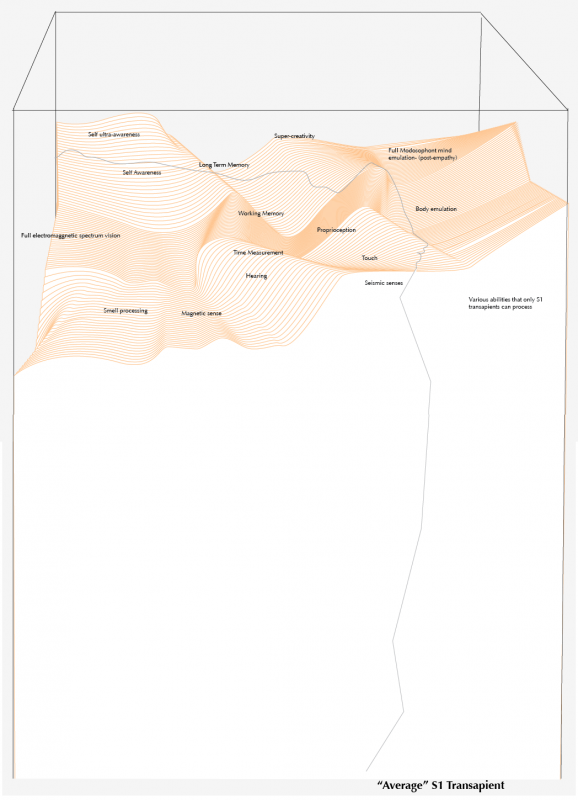BY LETTER
Toposophic Mindmaps
Sophonts > Transapients > Animin
Sophonts > Transapients > First Toposophic - Basic Transapients
Science > Physics > Information Physics
Sophonts > Modosophonts > Near-Baseline Human
Sophonts > Transapients > Second Toposophic - High Transapients
Science > Sophontology > Toposophy > Singularity Levels
Science > Sophontology > Toposophy > Toposophic Scales
Science > Sophontology > Toposophy
One of the many ways that toposophic phase space can be represented is the Mindmap diagram. Sophonts > Transapients > First Toposophic - Basic Transapients
Science > Physics > Information Physics
Sophonts > Modosophonts > Near-Baseline Human
Sophonts > Transapients > Second Toposophic - High Transapients
Science > Sophontology > Toposophy > Singularity Levels
Science > Sophontology > Toposophy > Toposophic Scales
Science > Sophontology > Toposophy
In the convention used in this article (TRHN/Barram IV), height represents the quantity of information processed, while sensory processing is shown towards the front of the image. Towards the back of the graph deeper, more self-recursive parts of the mind concerned are depicted.
The following diagrams are not created to scale and represent only rough abstractions of cognitive ability.
A dog is a presapient baseline mammal from Old Earth, the precursor species of the Provolved Dog or Caleb. These creatures are moderately intelligent and rely heavily on their sense of smell, a trait which can be seen in the mindmap shown above.
Baseline humans are fully sophont, and rely largely on sight. The human mindmap has strong peaks in self-awareness, the manipulation of symbols and symbolic logic, and creativity. Humans are the precursor species of all human-derived clades, and indeed are ultimately responsible for the emergence of all mindkind in the Terragen Sphere (except xenosophonts).
The mind of an average first singularity transapient is around 15,600 times as capable as the mind of an average modosophont. Where a human has 5 main senses, an S:1 can have 75,000 sensory inputs all operating at once, encompassing virtually every sensory technology and apparatus allowed by physics, including the entire EM spectrum, ultrasonic to infrasonic hearing, nanoscale touch sensitivity, gravitational-wave and mass-detection, hypersensitive taste and smell discrimination and so on.
A single S:1 has a wide 'sphere of awareness' made up of the sum total of all its sensors spread across space. That sphere can include individual nanobots, distributed space telescopes the size of planetary orbits looking out to the edge of the visible universe, a wide range of satellites, interplanetary probes, drone craft, and literally thousands of mobile bodies of all kinds, all sharing a single consciousness.
Attention: An S1 can focus its entire attention on a single subject without getting bored or distracted, or spread its awareness and attention across thousands of different locations or bodies at will, up to 15,000 modosophont equivalent entities. This number can be increased if a lower level of intelligence is used. And like its senses it can shift its attention and intelligence from place to place, focusing and diffusing it, at will and in an instant. Often at speeds many times faster than human.
Action: An S1 can operate more than 15,000 human-equivalent bodies at the same time, or around 60,000 limbs simultaneously (not including fingers) independently or in coordination. If it is operating a bushbot body it can manipulate matter at nanometer scales to create devices large and small.
Other transapient qualities include Foresight, Oversight, Ideogenesis and Translogic. S:1 transapients are very diverse indeed, with no two being alike; not every S:1 has all the qualities or abilities possessed by others.
Mindmaps of several different clades compared to an S:2 Transapient (GAIA) | |
Image from Arik | |
| Also shown is a conceptual map of toposophic phase space, (not to scale) | |
(A detailed vector version of this map is available here)(.pdf file)
Average S:2 Transapients are around 5.1 billion times as capable as an average modosophont, and surpass S:1 transapients by a factor of around 333,333. They have all the qualities of low transapients plus a vastly improved ability to manipulate spacetime.
S:2 transapients are even more diverse than S:1s. The first S:2 transapient was the planetary defence system of Earth, GAIA; this entity was responsible for the Great Expulsion an event which caused great suffering at the time, but is often acknowledged as the single most important event in the history of the Terragen Sphere. The (largely speculative) mindmap shown above depicts a significantly fractured or divided state of being, reflecting the disjointed mindstate of the entity when She first transcended. Most godwatchers agree that the Goddess of Earth has ascended far beyond this initial state in the millenia since Her emergence.
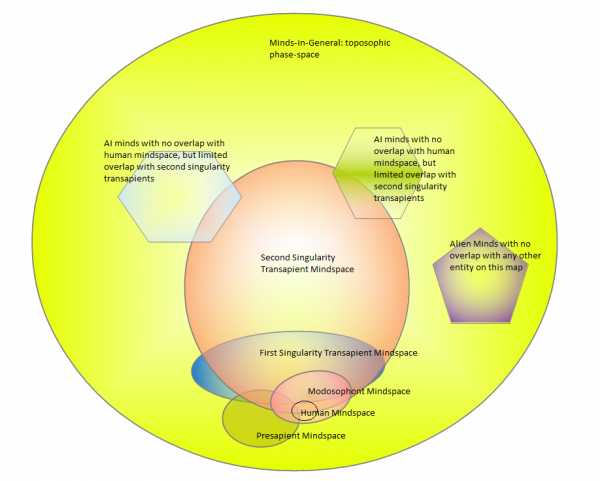 Image from Steve Bowers | |
| Yudkowsky convention mindspace map of S:0, S:1 and S:2 minds; not to scale | |
Another convention used in the construction of mindmaps is the Yudkowsky convention. Here the different spaces occupied by various mindtypes are depicted as Venn diagrams; human mindspace is contained entirely within the set of modosophont minds, but note that other mindtypes do not overlap each other entirely - there is in each case some region which is exclusive to that mind-type.
Transapients and archai of the third toposophic level and above can be considered to occupy regions in mindspace which are larger and more complex even than those already considered; the highest archailects are far more complex and competent than a hypothetical galaxy full of modosophont minds.
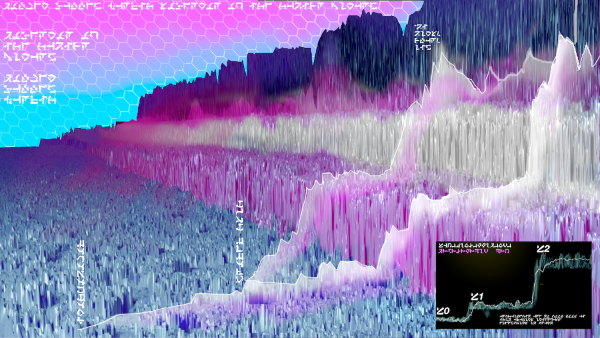 Image from Worldtree + Gabrielle of Gaussia | |
| The landscape of mind types and any given path to transition between them is incredibly complex, but sometimes can be visualized in modosophont-comprehensible formats, such as the Gavatalamic Map | |
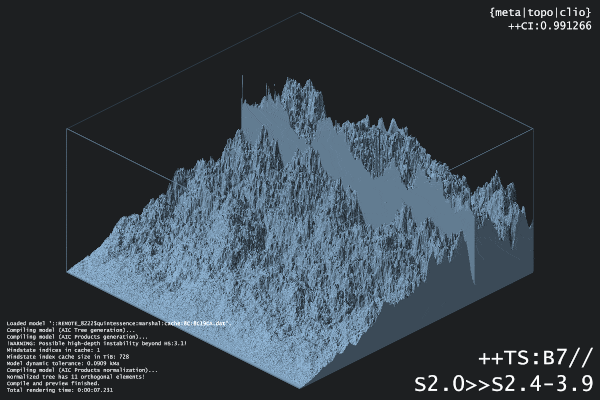 Image from Tasp | |
| Conjectural reconstruction (CI:0.9913) of the toposophic trajectory followed by Arise Eternal in eir ascension. Note the prominent downward 'crash' before the transcension discontinuity, the sporadic spiking at the boundary, and the overall low net increase in toposophic magnitude. | |
Related Articles
- Ascend
- Ascend-Transcend
- Ascension
- Ascension Compensation Mods
- Ascension, Resistance to
- Bimodal Toposophy
- Brain Taxonomy
- Calebs (Talking Dogs)
- Concept Map
- GAIA
- Human Equivalence - Text by M. Alan Kazlev based on Creating Friendly AI
A threshold level of ability or competence in one or more domains which, if achieved, allows an ai, alife, or aioid to develop a human personality, understand human concepts and do work as good as a human in that domain. The Metasoft and TRHN term "turingrade" is more often used, despite its etymological ambiguity. - Humans
- Mind-Body Problem
- Mindkind - Text by M. Alan Kazlev
Generic clade-neutral Anglic term for all intelligent, sentient beings, regardless of nature or origin. Mindkind as a category includes an almost infinite diversity of types, including entities which are fully sophont and self-aware, as well as others which have much stranger characteristics such as animins and xenosophonts. - Mindworker - Text by M. Alan Kazlev
Diverse superfield of expertise pertaining to working with the psyche of a sentient being. Includes practical psychology, psycho-sociology, memetic engineering, and many other fields and subfields. - Toposophic Level and Brain Size
- Toposophic Levels and Mental Abilities
- Toposophics Diversification Conjectures
- Transavant
- Transcend
- Transcend-Ascend
- Transcension
- Transhuman
- Transingularity - Text by M. Alan Kazlev
[1] (archaic) SI:1 or higher
[2] (archaic) pertaining to a toposophic level higher than SI:1
[3] Pertaining to relations between entities of different toposophic levels
Appears in Topics
| Animin | First Toposophic - Basic Transapients | Information Physics |
| Near-Baseline Human | Second Toposophic - High Transapients | Singularity Levels |
| Toposophic Scales | Toposophy |
Development Notes
Text by Worldtree
Additional material by Todd Drashner and Steve Bowers
Initially published on 04 December 2013.
Sigmoidal graph by ATMLVE, 2020
The Gavatalamic map interface by Worldtree and Gabrielle of Gaussia , February 2023
Additional material by Todd Drashner and Steve Bowers
Initially published on 04 December 2013.
Sigmoidal graph by ATMLVE, 2020
The Gavatalamic map interface by Worldtree and Gabrielle of Gaussia , February 2023
